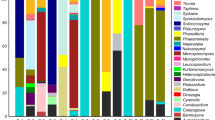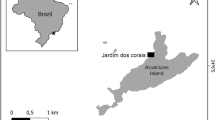Abstract
Filamentous fungi and yeasts associated with the marine algae Adenocystis utricularis, Desmarestia anceps, and Palmaria decipiens from Antarctica were studied. A total of 75 fungal isolates, represented by 27 filamentous fungi and 48 yeasts, were isolated from the three algal species and identified by morphological, physiological, and sequence analyses of the internal transcribed spacer region and D1/D2 variable domains of the large-subunit rRNA gene. The filamentous fungi and yeasts obtained were identified as belonging to the genera Geomyces, Antarctomyces, Oidiodendron, Penicillium, Phaeosphaeria, Aureobasidium, Cryptococcus, Leucosporidium, Metschnikowia, and Rhodotorula. The prevalent species were the filamentous fungus Geomyces pannorum and the yeast Metschnikowia australis. Two fungal species isolated in our study, Antarctomyces psychrotrophicus and M. australis, are endemic to Antarctica. This work is the first study of fungi associated with Antarctic marine macroalgae, and contributes to the taxonomy and ecology of the marine fungi living in polar environments. These fungal species may have an important role in the ecosystem and in organic matter recycling.


Similar content being viewed by others
References
Altuschul SF, Madden TL, Schaffer AA, Zhang JH, Zhang Z, Miller W, Lipman DJ (1997) Gapped BLAST and PSI-BLAST: a new generation of protein database search programs. Nucleic Acids Res 25:3389–3402
Arenz BE, Held BW, Jurgens JA, Farrell RL, Blanchette RA (2006) Fungal diversity in soils and historic wood from the Ross Sea Region of Antarctica. Soil Biol Biochem 38:3057–3064. doi:10.1016/j.soilbio.2006.01.016
Bridge PD, Newsham KK (2009) Soil fungal community composition at Mars Oasis, a southern maritime Antarctic site, assessed by PCR amplification and cloning. Fungal Ecol 2:66–74. doi:1016/j.funeco.2008.10.008
Bugni TS, Ireland CM (2004) Marine-derived fungi: a chemically and biologically diverse group of microorganisms. Nat Prod Rep 21:143–163. doi:10.1039/b301926h
Charpy-Roubaud C, Sourina A (1990) The comparative estimation of phytoplanktonic, microphytobenthic and macrophytobenthic primary production in the oceans. Mar Microb Food Webs 4:31–57
Donachie SP, Zdanowski MK (1998) Potential digestive function of bacteria in krill Euphausia superba stomach. Aquat Microb Ecol 14:129–136
Fell JW, Hunter IL (1968) Isolation of heterothallic yeast strains of Metschnikowia Kamienski and their mating reactions with Chlamydozyma Wickerham spp. Antonie van Leeuwenhoek 34:365–376. doi:10.1007/BF02046459
Fell JW, Statzel A, Hunter IL, Phaff HJ (1969) Leucosporidium gen. nov. The heterobasidiomycetous stage of several yeasts of the genus Candida. Antonie van Leeuwenhoek 35:433–462
Hawksworth DL (2004) Fungal diversity and its implications for genetic resource collections. Stud Mycol 50:9–18
Höller U, König GM, Wright AD (1999) Three new metabolites from marine-derived fungi of the genera Coniothyrium and Microsphaeropsis. J Nat Prod 62:114–118. doi:10.1021/np980341e
Jones EBG, Byrne PJ (1976) Physiology of the higher marine fungi. In: Jones EBG (ed) Recent advances in aquatic mycology. Wiley, New York, pp 1–51
Kirk PM, Cannon PF, David JC, Stalpers JA (2001) Ainsworth & Bisby’s dictionary of the fungi, 19th edn. CAB International, Wallingford
Kohlmeyer J, Kohlmeyer E (1979) Marine mycology. Academic Press Inc., New York, pp 54–69
Kohlmeyer J, Volkmann-Kohlmeyer B (1991) Illustrated key to the filamentous higher marine fungi. Bot Marina 34:1–61
Kohlmeyer J, Volkmann-Kohlmeyer B (2003) Marine ascomycetes from algae and animal hosts. Bot Marina 46:285–306
Kohlmeyer J, Volkmann-Kohlmeyer B, Eriksson OE (1998) Fungi on Juncus roemerianus. 11. More new ascomycetes. Can J Bot 76:467–477
Kurtzman CP, Fell JW (1998) The yeast: a taxonomic study, 4th edn. Elsevier, Amsterdam
Kuthubutheen AJ, Pugh GJ (1979) Effects of temperature and fungicides on Chrysosporium pannorum (Link) Hughes. Antonie van Leeuwenhoek 45:65–79. doi:10.1007/BF00400780
Lachance MA, Bowles JM, Starmer WT, Barker JSF (1999) Kodamaea kakaduensis and Candida tolerans, two new ascomycetous yeasts species from Australian Hibiscus flowers. Can J Microbiol 45:172–177. doi:10.1139/cjm-45-2-172
Lachance MA, Daniel HM, Meyer W, Prasad GS, Gautam SP, Boundy-Mills K (2003) The D1/D2 domain of the large-subunit rDNA of the yeast species Clavispora lusitaniae is usually polymorphic. FEMS Yeast Res 4:253–259. doi:10.1016/S1567-1356(03)00113-2
Mendonça-Hagler LC, Hagler AN, Phaff HJ, Tredick J (1985) DNA relatedness among aquatic yeasts of the genus Metschnikowia and proposal of the species Metschnikowia australis com. nov. Can J Microbiol 31:905–909. doi:10.1139/m85-170
Mercantini R, Marsella R, Cervellati MC (1989) Kerationphilic fungi isolated from Antarctic soil. Mycopathologia 106:47–52. doi:10.1007/BF00436926
Nedzarek A, Rakusa-Suszczewski S (2004) Decomposition of macroalgae and the release of nutrient in Admiralty Bay, King George Island, Antarctica. Polar Biosci 17:16–35
Poole N, Price P (1971) The occurrence of Chrysosporium pannorum in soils receiving incremental cellulose. Soil Biol Biochem 3:161–166
Rollo F, Sassaroli S, Ubaldi M (1995) Molecular phylogeny of the fungi of the Iceman’s grass clothing. Curr Genet 28:289–297
Rosa LH, Vaz ABM, Caligiorne RB, Campolina S, Rosa CA (2009) Endophytic fungi associated with the Antarctic Grass Deschampsia antarctica Desv. (Poaceae). Polar Biol 32:161–167. doi:10.1007/s00300-008-0515-z
Sampaio JP, Gadanho M, Bauer R, Weib M (2003) Taxonomic studies in the Microbotryomycetidae: Leucosporidium golubevii sp. nov., Leucosporidiella gen. nov. and the new orders Leucosporidiales and Sporidiobolales. Mycol Progress 2:53–68
Stanley SJ (1992) Observation on the seasonal occurrence of marine endophytic and parasitic fungi. Can J Bot 70:2089–2096. doi:10.1139/b92-259
Stchigel AM, Cano J, MacCormack CW (2001) Antarctomyces psychrotrophicus gen. et sp. nov., a new ascomycete from Antarctica. Mycol Res 105:377–382. doi:10.1017/S0953756201003379
Tamura K, Dudley J, Nei M, Kumar S (2007) MEGA4: Molecular Evolutionary Genetics Analysis (MEGA) software version 4.0. Mol Biol Evol 24:1596–1599. doi:10.1093/molbev/msm092
Taylor DL, Herriot IC, Long J, O’Neill K (2007) TOPO TA is A-OK: a test of phylogenetic bias in fungal environmental clone library construction. Environ Microbiol 9:1329–1334
Uspon R, Newsham KK, Bridge PD, Pearce DA, Read DJ (2009) Taxonomic affinities of dark septate root endophytes of Colobanthus quitensis and Deschampsia antarctica, the two native Antarctic vascular plant species. Fungal Ecol. doi:10.1016/j.funeco.2009.02.004
White TJ, Bruns TD, Lee SB (1990) Amplification and direct sequencing of fungal ribosomal RNA genes for phylogenetics. In: Innis MA, Gelfand J, Sninsky J, White TJ (eds) PCR protocols: a guide to methods and applications. Academic Press Inc., New York, pp 315–322
Wiencke C, Clayton MN, Gomez I, Iken K, Luder UH, Amsler CB, Karsten U, Hanelt D, Bischof K, Dunton K (2007) Life strategy, ecophysiology and ecology of seaweeds in polar waters. Rev Environ Sci Biotechnol 6:96–126. doi:10.1007/s11157-006-9106-z
Yarrow D (1998) Methods for the isolation, maintenance and identification of yeasts. In: Kurtzman CP, Fell JW (eds) The yeasts: a taxonomic study. Elsevier, Amsterdam, pp 77–105
Zuccaro A, Mitchell JI (2005) Fungal communities of seaweeds. In: Dighton J, White JF, Oudemans P (eds) The fungal community, 3rd edn. CRC Press, New York, pp 533–579
Zuccaro A, Schulz B, Mitchell JI (2003) Molecular detection of ascomycetes associated with Fucus serratus. Mycol Res 107:1451–1466. doi:10.1017/S0953756203008657
Zuccaro A, Schoch CL, Spatafora JW, Kohlmeyer J, Draeger S, Mitchell JI (2008) Detection and identification of fungi intimately associated with the brown seaweed Fucus serratus. Appl Environ Microbiol 74:931–941. doi:10.1128/AEM.01158-07
Acknowledgments
This study was made possible with financial and logistic support from the Brazilian Antarctic Programme (PROANTAR). It is part of the API activity 403 “MIDIAPI Microbial Diversity of Terrestrial and Maritime ecosystems in Antarctic Peninsula” under the overall coordination of Dr. Vivian H. Pellizari, and contributes to the umbrella IPY activities MERGE (Microbiological and Ecological Responses to Global Environmental Changes in Polar Regions), CAML (Census of Antarctic Marine Life), and SCARMarBIN (SCAR-Marine Biodiversity Information Network). The work was financially supported by the Fundação of Amparo, the Pesquisa of the Minas Gerais (FAPEMIG) and Conselho Nacional of Desenvolvimento Científico and Tecnológico (CNPq). We thank an anonymous reviewer of Polar Biology journal for helpful comments to improve the quality of the manuscript.
Author information
Authors and Affiliations
Corresponding author
Rights and permissions
About this article
Cite this article
Loque, C.P., Medeiros, A.O., Pellizzari, F.M. et al. Fungal community associated with marine macroalgae from Antarctica. Polar Biol 33, 641–648 (2010). https://doi.org/10.1007/s00300-009-0740-0
Received:
Revised:
Accepted:
Published:
Issue Date:
DOI: https://doi.org/10.1007/s00300-009-0740-0




